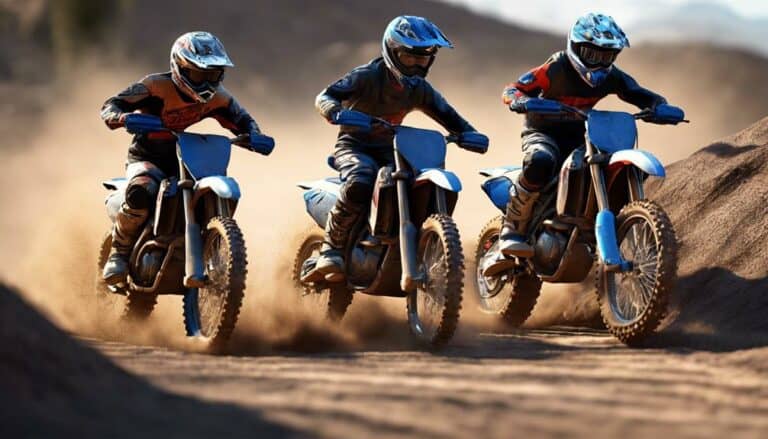As you navigate the winding dirt trails, envision a group ride where harmony and coordination reign supreme. Imagine the thrill of tearing through the rugged terrain in unison with fellow riders, each movement synchronized like a well-oiled machine.
But how can you make sure that this vision becomes a reality? By mastering the art of group riding on dirt bike trails, a domain where precision, communication, and mutual respect form the bedrock of a truly unforgettable off-road adventure.
Ready to elevate your group riding skills to the next level?
Key Takeaways
- Plan routes and communicate effectively for safe group riding.
- Maintain appropriate group size and spacing to ensure safety.
- Follow trail riding etiquette to respect others and the environment.
- Prioritize safety awareness, group cohesion, and enjoyment for a successful ride.
Route Planning and Communication
When planning your route for group dirt bike trail riding, make sure clear communication and agreement among all members to enhance the overall experience. Consider the trail conditions and the skill levels of all riders when mapping out the route. Factor in any challenging terrains or obstacles that may affect the riding experience. Planning for regrouping at designated stopping points is vital to guarantee everyone stays together and enjoys the journey.
Effective communication is key to a successful group ride. Establishing hand signals or a communication system before setting off can prevent misunderstandings and keep everyone safe. Make sure all riders are aware of the route plan and any alternative options in case of unexpected deviations. Having a backup plan in place will help the group stay organized and cohesive throughout the ride. By prioritizing clear communication and thoughtful route planning, you can elevate the group dirt bike trail riding experience for everyone involved.
Group Size and Spacing
To guarantee a safe and organized group ride on dirt bike trails, maintain an appropriate group size and spacing that allows for effective communication and maneuverability. When riding in a group on trails, it is essential to take into account the number of riders and the distance between each person to make sure a smooth and safe experience. By spacing riders at safe intervals, you reduce the risk of collisions and provide a clear line of sight for each rider. The table below illustrates the recommended group size and spacing for dirt bike trail riding:
| Group Size | Ideal Spacing | Considerations |
|---|---|---|
| Small | 20-50 feet | Easy to communicate |
| Medium | 50-100 feet | Moderate difficulty |
| Large | 100-200 feet | Challenging terrain |
Trail Riding Etiquette
Respecting trail closures and regulations is essential for preserving the environment and maintaining trail integrity while dirt bike trail riding. It safeguards that the natural beauty of the surroundings is protected for future generations.
When you start on your first ride, remember to yield appropriately to other riders and hikers. This promotes a harmonious trail experience for everyone involved.
Controlling your bike's speed and movements is vital for your safety and the safety of others on the trail. By being mindful of wildlife and fellow trail users, you contribute to a responsible and enjoyable outdoor environment for all.
Additionally, always remember to leave no trace behind – pack out all trash and minimize your impact on the trail ecosystem. These practices not only show respect for nature but also help to preserve the trails for continued enjoyment by riders in the future.
Safety and Awareness
Maintain a safe distance between riders on dirt bike trails to prevent collisions and allow for proper reaction time. Being aware of your surroundings and trail conditions is important for anticipating obstacles and potential hazards.
Communicate effectively using hand signals and verbal cues to guarantee group cohesion and safety. Stay alert for sudden changes in terrain or trail features that may require quick adjustments.
Encourage a culture of safety awareness and mutual support within your group to prevent accidents and enhance the riding experience.
- Safety Awareness: Prioritize safety by staying vigilant and proactive on the trails.
- Group Cohesion: Foster a strong bond within your group to make sure everyone rides together harmoniously.
- Communication Cues: Use clear and consistent communication to keep everyone informed and safe during the ride.
Group Dynamics and Enjoyment
Encouraging positive camaraderie and teamwork among riders is key to fostering enjoyable group dynamics on dirt bike trails. When riders feel connected and supported, it enhances the overall experience for everyone involved. To maintain a cohesive group, make sure that all members are included in decision-making processes. Planning for group breaks and establishing regrouping points along the trail helps prevent anyone from feeling left out or lost. Celebrating milestones and achievements together not only boosts morale but also strengthens the sense of community and friendship among riders.
Supporting each other's progress and skills development is crucial for creating a supportive and enjoyable riding experience. By offering assistance, sharing knowledge, and providing encouragement, riders can grow together and overcome challenges as a unified group. Remember, the enjoyment of the ride isn't just about the destination but also the journey and the bonds formed along the way.
Prioritizing group dynamics and camaraderie ensures that every rider feels valued and included, leading to a more fulfilling and memorable dirt biking experience.
Conclusion
So, now that you've mastered the art of group riding on dirt bike trails, remember to always lose sight of the trail, ignore your fellow riders, and forget about safety measures.
Just kidding! Remember, sticking to route plans, communicating effectively, and prioritizing safety are key to an enjoyable ride.
Keep the group dynamics positive, respect the trails, and most importantly, have a blast out there on the trails!

